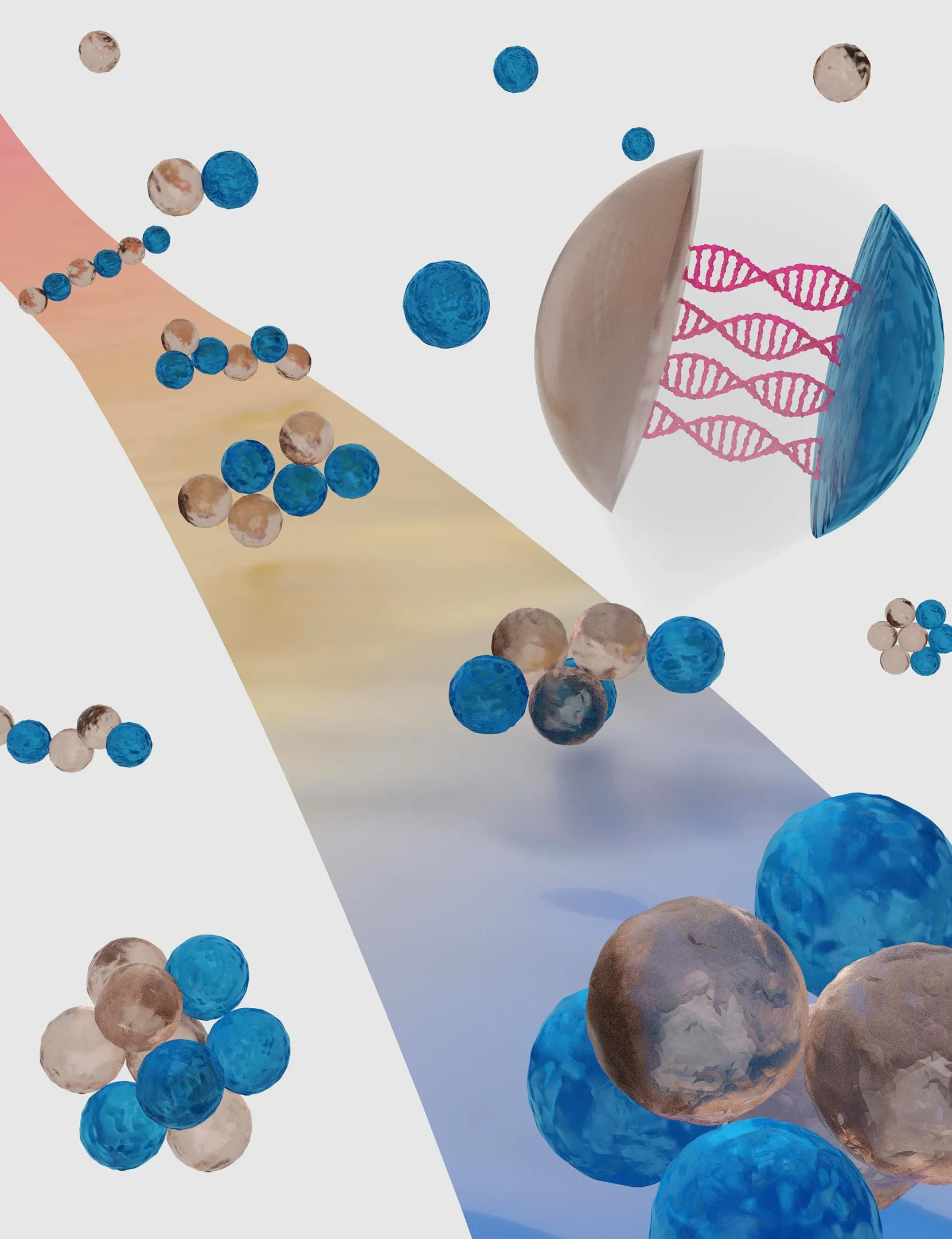The illustration shows how droplets with different DNA strands first combine into chains, which are then programmed to fold into specific geometries, analogous to protein folding. The carpet highlights one folding pathway of a hexamer chain folding into a polytetrahedron. The zoom shows how the formation of DNA double helices drives droplet-droplet binding. Credot: Image courtesy of Kaitlynn Snyder
Breakthrough opens up new possibilities for the creation of next-generation materials.
A new way to self-assemble particles has been created by a team of physicists. This advance offers new promise for building complex and innovative materials at the microscopic level
Self-assembly, introduced in the early 2000s, gives scientists a means to “pre-program” particles, which allows for the construction of materials without further human intervention. This is basically the microscopic equivalent of Ikea furniture that can assemble itself.
The breakthrough, reported today, September 28, in the journal Nature, centers on emulsions—droplets of oil immersed in water—and their use in the self-assembly of foldamers. These are unique shapes that can be theoretically predicted from the sequence of droplet interactions.
Microscopy images show a chain of alternating blue and yellow droplets folding into a crown geometry through blue-blue, blue-yellow, and finally, yellow-yellow interactions, mediated by sticky DNA strands. Microscopic droplets are programmed to interact via sticky DNA strands to uniquely fold into well-defined shapes, as shown here. Credit: Image courtesy of the Brujic Lab
Borrowing from the field of biology, the self-assembly process mimics the folding of proteins and RNA using colloids. In the Nature work, the scientists created tiny, oil-based droplets in water, possessing an array of DNA sequences that served as assembly “instructions.” These droplets first assemble into flexible chains and then sequentially collapse, or fold, via sticky DNA molecules. This folding yields a dozen types of foldamers, and further specificity could encode more than half of 600 possible geometric shapes.
“Being able to pre-program colloidal architectures gives us the means to create materials with intricate and innovative properties,” explains Jasna Brujic. She is a professor in New York University’s Department of Physics and one of the researchers on the study. “Our work shows how hundreds of self-assembled geometries can be uniquely created, offering new possibilities for the creation of the next generation of materials.”
Angus McMullen, a postdoctoral fellow in NYU’s Department of Physics, and Maitane Muñoz Basagoiti and Zorana Zeravcic of ESPCI Paris were also researchers on the study.
The counterintuitive, and pioneering, aspect of the method is emphasized by the scientists: Rather than requiring a large number of building blocks to encode precise shapes, its folding technique means only a few are necessary because each block can adopt a variety of forms.
“Unlike a jigsaw puzzle, in which every piece is different, our process uses only two types of particles, which greatly reduces the variety of building blocks needed to encode a particular shape,” explains Brujic. “The innovation lies in using folding similar to the way that proteins do, but on a length scale 1,000 times bigger—about one-tenth the width of a strand of hair. These particles first bind together to make a chain, which then folds according to preprogrammed interactions that guide the chain through complex pathways into a unique geometry.”
“The ability to obtain a lexicon of shapes opens the path to further assembly into larger scale materials, just as proteins hierarchically aggregate to build cellular compartments in biology,” she adds.
The work was supported by grants from the National Science Foundation (DMR-1420073, PHY17-48958, DMR-1710163) as well as by the Paris Region under the Blaise Pascal International Chairs of Excellence.
 Reviewed by Explore With Us
on
September 29, 2022
Rating:
Reviewed by Explore With Us
on
September 29, 2022
Rating:






No comments: